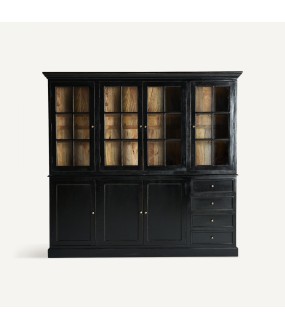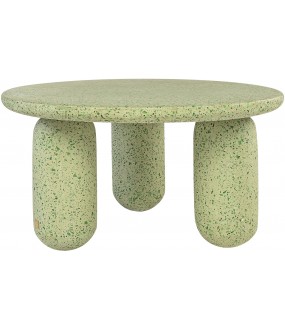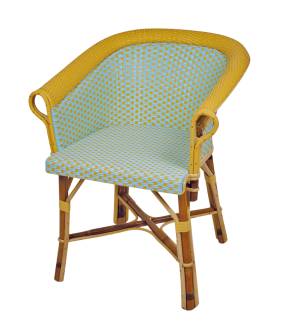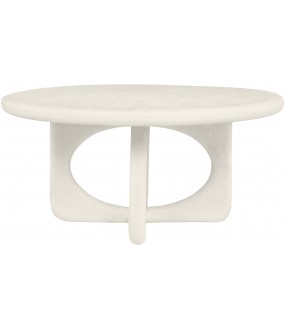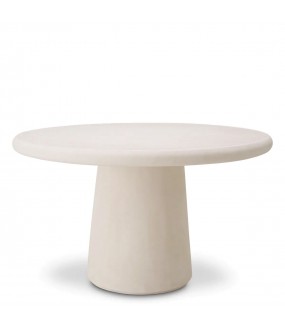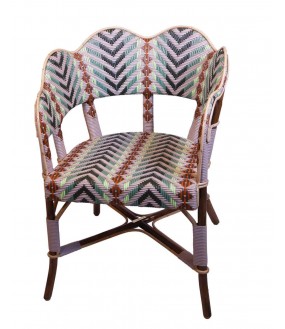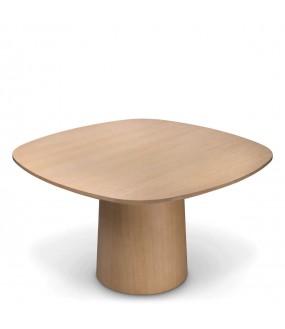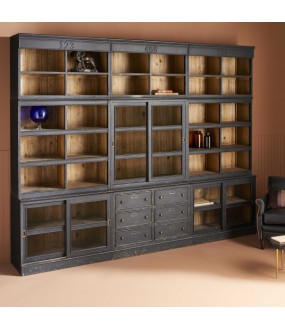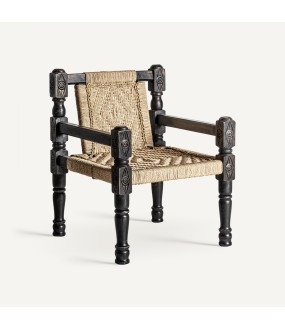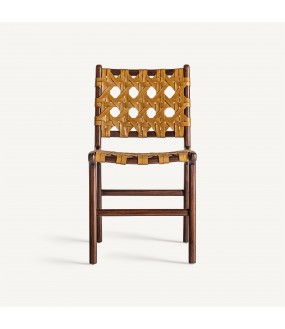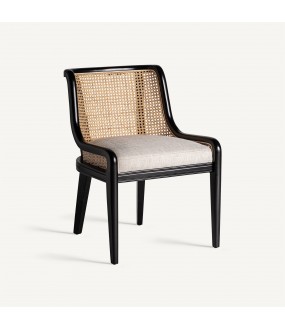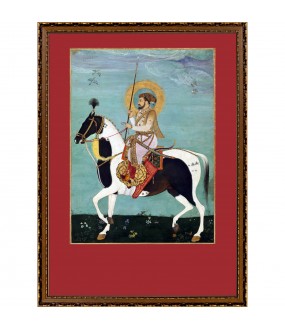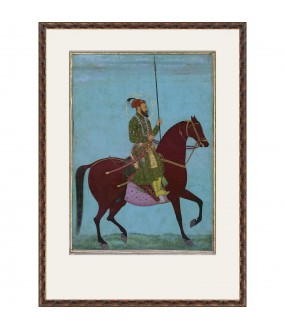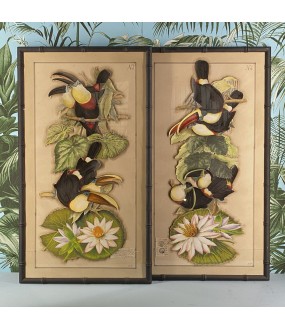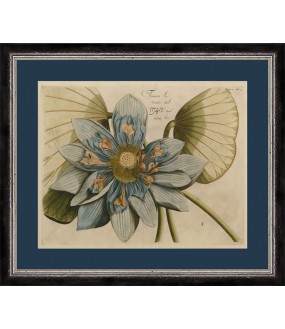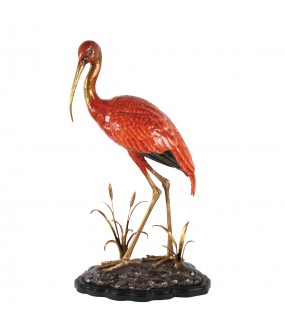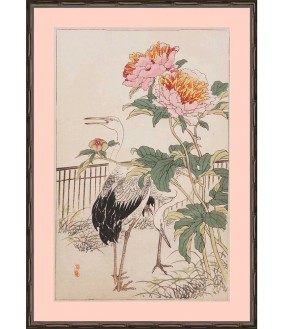New Items

Find all the new interior decoration items of Arteslonga: sofas, chairs, objects of curiosities, decorative accessories...
-
Library Edgard XIXth Style, Double Body
€5,280.00The large Edgard library consists of a double body and has the particularity of having an apothecary style from the beginning of the 19th century.
This large bookcase, made entirely of solid mango wood, is made up of 2 independent modules, top (dresser cabinet) and bottom (sideboard), which will dress your interior in a majestic way.
The two upper and lower parts can be offered for sale separately.
The aged black patina and its solid old mango wood interior give it an old look as if it had come out of a natural history museum.
The complete piece of furniture (upper and lower part) measures 430cm high by 218cm wide by 42cm deep. Total weight 170kg.
Dimensions of the upper glazed part which consists of 4 doors and 4 shelves:
Length: 218cm - Depth: 42cm - Height: 113cm
Dimensions of the lower part which consists of a single block of 4 doors and 4 drawers:
Length: 212cm - Depth: 40cm - Height: 92cm
This large bookcase will also go very well with an industrial style.
Delivery on the ground floor only.
For upstairs delivery, please contact us.
-
Round Table Cosmos ø150cm, Smoked Eucalyptus...
€2,994.00The Cosmos round table.
A beautiful round table of contemporary realization in the minimalist raw style designed in Smoked Eucalyptus Veneer color roasted coffee brown.
Eucalytus is an exotic wood of great beauty with a marked grain, close to rosewood, which will delight wood lovers.
The top of the Cosmos round table is large and measures 150cm in diameter.
Central base for a beautiful appearance of the whole table and perfect stability.
A table of perfect execution and solidity for a modern and chic interior.
Material: Steel Footplate and Smoked Eucalyptus Veneer
Leg Finish : Black Powder Coated Footplate
Diameter (cm): 150
Height (cm): 76
Volume (m3): 0.443
Thickness Top (cm): 7.5
Thickness Leg (cm): Pillar Ø37 Footplate Ø78.5
Av. Armchair Height (cm) 68.5
Nett Weight (kg) 124
Unassembled delivery.
The top is protected against stains.
Due to the natural characteristic of the eucalyptus wood, the veneer can have a large variation in grain/pattern. Each veneer sheet will react differently to the smoking process and can be lighter or darker. Our craftsmen personally select the veneer which is used for the table to get the best color and grain/pattern match possible.
-
Coffee Table Granito ø80cm, Green or White
€920.00The Granito coffee table is a contemporary artisanal creation designed in terrazzo encrusted with pieces of glass.
Terrazzo, used since Antiquity, is an assembly of colored marble debris (or glass, granite, etc.) bound by cement. At the time, Venetian craftsmen inlaid pieces of stone and glass into the floors in order to reuse surplus materials from their workshops.
Original coffee table with a raw and minimalist design, unique manufacturing, contemporary craftsmanship.
A coffee table with incredible strength and an original design.
If you are looking for a unique piece of furniture in the raw and minimalist style, this coffee table is made for you!
Due to its handcrafted design, each console has a unique expression.
An explosive design for this coffee table.
This large Terrazzo coffee table benefits from great stability and extreme solidity.
-
Rattan Armchair Fully Woven Backrest
€1,780.00Very welcoming armchair with its fully woven backrest.
This colorfully woven rattan armchair adds a colorful and caned touch to your interiors, to your terraces, hotels, restaurants or cafés.
Indoor / Outdoor: Semi-Outdoor
Overall width: 50 cm
Overall depth: 53 cm
Overall height: 78 cm
Weight: 6kg
Seat width: Wide seat (43cm)
Seat height: 45 cm
Height of the armrests: 62 cm
Stackability: Not stackable
Availability: Made to order
Weaving fibers: Brilliant (Rilsan)
Caning range: Basic
Colours: Brilliant Azure Blue, Brilliant Cream
Varnish and paint: Varnish
Structure materials: Dark rattan (Malacca)
Alternative Structure Materials: Outdoor – Aluminum Structure, Light Rattan (Manila), Dark Rattan (Malacca)
Chassis weaving finishes: Tradition
Rattan is a material with extraordinary properties but with limits. Rattan is a vine of the Palm race, which grows in very humid or even swampy equatorial forests.
With its siliceous skin like glass, this extremely solid and light vine is particularly resistant to humidity, as are tropical woods, teak or others.
But this resistance has its limits. Exposed to rain, rattan resists very well for a whole day or even a few days. But if this rain continues for too many hours, the humidity will gradually penetrate the Rattan, and day after day the material kept damp will end up slowly degrading and losing its resistance qualities.
The physical limits of rattan imply precautions for use. On the terraces of Parisian cafes, the chairs can last for decades while they are often in the rain all day for long periods. But they are piled up every night under cover and can thus dry out.
More generally, rattan can withstand rain for long hours without compromising its longevity, but must be able to dry regularly.
In practice, rattan furniture can stay outside throughout the "summer season", the weather is hot and rather dry, continuous rains exceptionally last more than three or four days and Rattan withstands such rains without degrading.
But as soon as the season advances, the temperature drops, there is a lot of condensation and humidity, the Rattan will gradually become humid, the long and heavy rains accentuating this degradation. In practice, these are sensitive situations by the sea.
It is then imperative to put the seats under shelter, a ventilated shelter to avoid progressive humidification as soon as the "bad season" arrives, in practice from mid-October to mid-March for a continental climate.
The alternative if you want to use your Rattan furniture all year round, is to put it away daily, every evening, as Parisian terraces do.
In summary, 2 main principles to respect:
During the winter season (October 15 to March 15 in Europe) in all climates: the furniture must be stored “dry”. It can however be left outside during the day, but must imperatively be put in the dry during the night.
During the "beautiful season", the rest of the time, the Rattan can remain permanently outside.
However, if a lasting rain arrives, the Rattan should only be left in this rain for two or three days at the most, before putting the furniture in the dry place so that it can dry. He only takes it out once the rain has stopped (In any case, a terrace cannot be used in the rain).
-
Round Coffee Table Hera ø90cm, Off White or Black
€1,068.00Hera Round Coffee Table ø90cm, Off White or Black
The Hera coffee table is a contemporary artisanal creation designed in GRP (glass reinforced polyester).
Original coffee table with a raw and minimalist design, unique manufacturing, contemporary craftsmanship.
A coffee table with incredible strength and an original design.
If you are looking for a unique piece of furniture in the raw and minimalist style, this coffee table is made for you!
Due to its artisanal design, each Hera coffee table has a unique expression.
An explosive design for this coffee table.
This large ø90cm coffee table in GRP benefits from great stability and extreme solidity.
-
Garden Round Table in Fiberglass ø132,5cm
€2,520.00The Concrete Round Garden Table ø132.5cm
A beautiful round table of contemporary realization in the minimalist raw style designed in fiberglass reinforced with concrete.
The top of the Supernova round table is large and measures 132.5cm in diameter.
Slightly conical central base for a beautiful appearance of the whole table and perfect stability.
A table of perfect execution and solidity for modern and chic outdoor use.
-
Rattan Armchair Green, Made On Order
€1,780.00The Gabrielle chair. Superb handcrafted armchair in woven rattan.
Manufacturing on demand.
Welcoming with its fully woven backrest and its generous shapes, the Gabrielle armchair is an armchair for restaurants, bistros, cafés, gardens or dining rooms in woven rattan in the colors of your desires, non-stackable and is as beautiful inside as it is outside.
Very comfortable, the Gabrielle armchair is light and very resistant.
This armchair will beautify your living room, your kitchen, your terrace, your veranda or your restaurant.
A magnificent French craftsmanship, the Gabrielle armchair is entirely handmade.
Type: chair with wide seat 43cm
Stackability: Not stackable
Indoor/Outdoor: Semi-Outdoor
Fiber: Satin (Raucord)
Colours: Satin Beige – Pantone 7502, Satin Ultramarine Blue – Pantone 534, Satin Royal Blue, Satin Terracotta, Satin Olive Green – Pantone 5743
Structure materials: Dark rattan (Malacca)
Weaving range: exceptions
Colours: Satin Beige – Pantone 7502, Satin Ultramarine Blue – Pantone 534, Satin Royal Blue, Satin Terracotta, Satin Olive Green – Pantone 5743
Seat height: 45cm
Seat width: Wide seat (43 cm).
Overall height: 81cm
Overall width: 58cm
Overall depth: 63cm
Weight: 7kg
Varnish and paint: Varnish
Rattan, a material with extraordinary properties with limits.
Rattan is a vine of the Palm race, which grows in very humid or even swampy equatorial forests.
With its siliceous skin like glass, this extremely solid and light vine is particularly resistant to humidity, as are tropical woods, teak or others.
But this resistance has its limits. Exposed to rain, rattan resists very well for a whole day or even a few days. But if this rain continues for too many hours, the humidity will gradually penetrate the Rattan, and day after day the material kept damp will end up slowly degrading and losing its resistance qualities.
The physical limits of rattan imply precautions for use. On the terraces of Parisian cafes, the chairs can last for decades while they are often in the rain all day for long periods. But they are piled up every night under cover and can thus dry out.
More generally, rattan can withstand rain for long hours without compromising its longevity, but must be able to dry regularly.
In practice, rattan furniture can stay outside throughout the "summer season", the weather is hot and rather dry, continuous rains exceptionally last more than three or four days and Rattan withstands such rains without degrading.
But as soon as the season advances, the temperature drops, there is a lot of condensation and humidity, the Rattan will gradually become humid, the long and heavy rains accentuating this degradation. In practice, these are sensitive situations by the sea.
It is then imperative to put the seats under shelter, a ventilated shelter to avoid progressive humidification as soon as the "bad season" arrives, in practice from mid-October to mid-March for a continental climate.
The alternative if you want to use your Rattan furniture all year round, is to put it away daily, every evening, as Parisian terraces do.
In summary, 2 main principles to respect:
During the winter season (October 15 to March 15 in Europe) in all climates: the furniture must be stored “dry”. It can however be left outside during the day, but must imperatively be put in the dry during the night.
During the "beautiful season", the rest of the time, the Rattan can remain permanently outside.
However, if a lasting rain arrives, the Rattan should only be left in this rain for two or three days at the most, before putting the furniture in the dry place so that it can dry. He only takes it out once the rain has stopped (In any case, a terrace cannot be used in the rain).
En savoir plus sur ce texte sourceVous devez indiquer le texte source pour obtenir des informations supplémentaires
Envoyer des commentaires
Panneaux latéraux
-
Magnificent Green Rattan Chair, Made on Order
€1,398.00Superb handcrafted rattan chair, made on demand.
This cane chair is ideal for your terrace, in your garden but also for your interior.
Very comfortable, this exceptional rattan chair is light and very resistant.
This chair will beautify your living room, your kitchen, your terrace, your veranda or your restaurant.
A magnificent French craftsmanship, this chair is entirely handmade.
Type: chair with wide seat 43cm
Stackability: Not stackable
Indoor/Outdoor: Indoor, Outdoor friendly
Fiber: Satin (Raucord)
Structure materials: Dark rattan (Malacca)
Weaving range: exceptions
Colours: Satin Beige – Pantone 7502, Satin Ultramarine Blue – Pantone 534, Satin Royal Blue, Satin Terracotta, Satin Olive Green – Pantone 5743
Seat height: 45cm
Seat width: Wide seat
Overall height: 81cm
Overall width: 58cm
Overall depth: 63cm
Weight: 7kg
Varnish and paint: Varnish
Rattan, a material with extraordinary properties with limits.
Rattan is a vine of the Palm race, which grows in very humid or even swampy equatorial forests.
With its siliceous skin like glass, this extremely solid and light vine is particularly resistant to humidity, as are tropical woods, teak or others.
But this resistance has its limits. Exposed to rain, rattan resists very well for a whole day or even a few days. But if this rain continues for too many hours, the humidity will gradually penetrate the Rattan, and day after day the material kept damp will end up slowly degrading and losing its resistance qualities.
The physical limits of rattan imply precautions for use. On the terraces of Parisian cafes, the chairs can last for decades while they are often in the rain all day for long periods. But they are piled up every night under cover and can thus dry out.
More generally, rattan can withstand rain for long hours without compromising its longevity, but must be able to dry regularly.
In practice, rattan furniture can stay outside throughout the "summer season", the weather is hot and rather dry, continuous rains exceptionally last more than three or four days and Rattan withstands such rains without degrading.
But as soon as the season advances, the temperature drops, there is a lot of condensation and humidity, the Rattan will gradually become humid, the long and heavy rains accentuating this degradation. In practice, these are sensitive situations by the sea.
It is then imperative to put the seats under shelter, a ventilated shelter to avoid progressive humidification as soon as the "bad season" arrives, in practice from mid-October to mid-March for a continental climate.
The alternative if you want to use your Rattan furniture all year round, is to put it away daily, every evening, as Parisian terraces do.
In summary, 2 main principles to respect:
During the winter season (October 15 to March 15 in Europe) in all climates: the furniture must be stored “dry”. It can however be left outside during the day, but must imperatively be put in the dry during the night.
During the "beautiful season", the rest of the time, the Rattan can remain permanently outside.
However, if a lasting rain arrives, the Rattan should only be left in this rain for two or three days at the most, before putting the furniture in the dry place so that it can dry. He only takes it out once the rain has stopped (In any case, a terrace cannot be used in the rain).
-
Round Table Atrium ø130cm
€3,600.00The Atrium round table.
A beautiful round table of contemporary realization in the contemporary style designed in Mindi wood veneer, natural oak color.
Mindi (or mindy) is an exotic wood of great beauty with a marked grain, close to rosewood, which will delight lovers of wood.
Immerse yourself in the world of opulence with the Atrium dining table.
Achieving unparalleled luxury and refined design, its natural mindi wood veneer and square shape with rounded corners create timeless elegance.
A symbol of sophistication, the Atrium round dining table will embellish and magnify your dining room to new heights of elegance.
The round top of the Atrium table measures 130cm in diameter.
Slightly conical central base for a beautiful appearance of the whole table and perfect stability.
A table of perfect execution and solidity for a modern and chic interior.
Diameter (cm): 130
Height (cm): 76
Top thickness (cm): 3
-
Round Table Tuscany in Walnut ø136cm
€3,450.00The Tuscany round table.
A beautiful round table of contemporary realization in the contemporary style designed in Walnut wood veneer, brown color.
Immerse yourself in the world of opulence with the Tuscany dining table.
Achieving unparalleled luxury and refined design, its walnut wood veneer and its round shape create timeless elegance.
The design of the base gives it a sense of lightness while maintaining the precious wood solidity.
A symbol of sophistication, the Tuscany round dining table will embellish and magnify your dining room to new heights of elegance.
The round top of the Tuscany table measures 136cm in diameter.
Unique central base for a beautiful appearance of the whole table and perfect stability.
A table of perfect execution and solidity for a modern and chic interior.
Diameter (cm): 136
Height (cm): 75
Top thickness (cm): 3
Veneered furniture is covered with a thin layer of real wood. Wood veneer is often used on high-end furniture and is sometimes more expensive than solid wood. This process became particularly popular in interiors in the middle of the 20th century, where teak wood was often used for Danish designer furniture.
To take full advantage of your veneered wood furniture, please observe a few basic rules:
- Avoid exposure to direct sunlight, as well as humidity and extreme temperature variations
- Be careful not to leave a round of moisture on the surface after watering plant flowers.
- Do not expose furniture to scratches from pets or sharp objects.
- Use coasters and slip pads under lamp bases and accessories.
-
Alexeï Library XIXth Style
€3,260.00The large library Alexei has the distinction of having a style both charm and industry.
This two body made entirely of pine is composed of 3 independent modules that will dress your wall in a fun way.
The aged black patina and its interior in natural wood color gives it an authentic charm. -
Alexeï Library XIXth Style - Separate Columns
€3,260.00The Alexeï library has the particularity of having an "industrial" apothecary style from the beginning of the 19th century. The exterior patina is aged black, old wood interior finish.
1 - The glass column is made up of a lower part with 2 sliding glass doors and 10 open storage lockers
2 - The column with drawers is composed in the lower part of 6 drawers, 2 high sliding glass doors in front of 6 storage lockers, 4 open storage lockers.
If you assemble 2 glass columns with a central column with drawers you can create a large and beautiful bookcase Bookcase 300cm long by 240cm high which will dress your wall in a majestic and playful way.
The aged black patina and its old wood interior give it an old appearance as if it came from a natural history museum.
This large bookcase will also go very well with an industrial style.
Delivery to the ground floor exclusively or upon request for a quote.
-
Carved Wood and Cane Armchair Angkor
€760.00Dining chair with three legs made of solid Suar wood.
A remarkable and unusual seat, in the raw and minimalist style entirely made of Suar wood and polished by hand, magnificent around a large dining table or outside in your garden, on a shaded terrace, around a swimming pool or a pretty decorated balcony.
Handmade and natural items, also details and finishes may vary and, due to handcrafted production, variations in finish are possible.
All the wood used is old wood, root wood or driftwood. The wood may contain natural cracks and holes, some of which could be repaired with the same wood at the workshop.
-
Antique Jar, unique item, H135cm
€1,600.00A unique antique item.
Very beautiful amphora (or jar) 135cm high by 92cm wide.
Beautiful and large dimensions for this room to place in an entrance, on a terrace, at the edge of a swimming pool...
She will undoubtedly find a place where she will beautify your interior or exterior decor.
A beautiful unique piece handcrafted in terracotta.
Weight: 90.0 kg.
- Diameter of the neck of the amphora: 40 cm
- No hole for drainage
-
Teak and Ocher Leather Chair
€492.00A chair in a raw and natural style made of solid teak for the structure and ocher-tinted and hand-woven leather for the seat and back.
This leather and wood chair can support up to 120kg.
Elegantly woven seat and back with thick strips of ocher-colored leather.
Original around a large dining table or in your living room.
Handmade and natural item, so details and finishes may vary.
-
Colonial Style Chair Rubberwood and Cannage
€760.00A beautiful and elegant chair in the colonial style made of solid rubber wood for the structure, polyester fabric for the seat cushion and canework for the back and side of the armrests.
This seat is crazy elegant and conveys a timeless natural chic thanks to a fluid design.
A very beautiful seat to place around a large dining table or in your living room.
Handmade item.
Rubberwood is an exotic wood that is both hard and resistant and this solid chair can therefore support up to 120kg.
-
Engraving of Shah Jahan on Horseback 50x70cm
€360.00Magnificent engraving of Shah Jahan parading on horseback.
Beautiful warm and deep colors, aged carved wood frame.
Dimensions of the glass pane: 50x70cm.
Mirza Shahab-ud-Din Baig Muhammad Khan Khurram (5 January 1592 – 22 January 1666), also known as Shah Jahan I, literally 'King of the World', was the fifth Mongol emperor, reigning from 1628 to 1658. Under his reign, the Mongols reached the height of their architectural achievements and cultural glory.
Third son of Jahangir (r. 1605-1627), Shah Jahan participated in military campaigns against the Rajputs of Mewar and the Lodis of the Deccan. After Jahangir's death in October 1627, Shah Jahan defeated his youngest brother Shahryar Mirza and crowned himself emperor in Agra Fort. In addition to Shahryar, Shah Jahan executed most of his rival claimants to the throne. He commissioned many monuments, including the Red Fort, the Shah Jahan Mosque and the Taj Mahal, where his favorite wife, Mumtaz Mahal, is buried. In foreign affairs, Shah Jahan presided over aggressive campaigns against the Deccan sultanates, conflicts with the Portuguese, and wars with the Safavids. He also put down several local rebellions and faced the devastating Deccan famine of 1630–32.
In September 1657, Shah Jahan fell ill and appointed his eldest son Dara Shikoh as his successor. This appointment led to a succession crisis among his three sons, of which Shah Jahan's third son, Aurangzeb (r. 1658–1707), emerged victorious and became the sixth emperor, executing all of his surviving brothers, including the Crown Prince Dara Shikoh. After Shah Jahan recovered from his illness in July 1658, Aurangzeb imprisoned his father at Agra Fort from July 1658 until his death in January 1666.[6] He was buried next to his wife in the Taj Mahal. His reign is known for putting an end to the liberal policies initiated by Akbar.
During Shah Jahan's era, Islamic revival movements like the Naqshbandi began to shape Mongolian politics.
-
Engraving of Aurangzeb 50x70cm
€360.00Magnificent engraving of Aurangzeb parading on horseback.
Beautiful warm and deep colors, aged carved wood frame.
Dimensions of the glass pane: 50x70cm.
Muhi al-Din Muhammad (c. 1618 – March 3, 1707), commonly known as Aurangzeb lit. 'Ornament of the throne' and by his royal name Alamgir I, lit. 'Conqueror of the world', was the sixth Mughal emperor, reigning from 1658 until his death in 1707.
Under his reign, the Mongol empire reached its peak with a territory covering almost the entire Indian subcontinent.
Widely considered the last effective Mongol ruler, Aurangzeb compiled the Fatawa 'Alamgiri and was among the few monarchs to fully establish Sharia law and Islamic economics throughout the Indian subcontinent.
Aurangzeb belonged to the aristocratic Timurid dynasty, held administrative and military positions under his father Shah Jahan (r. 1628–1658), and was recognized as an accomplished military commander. Aurangzeb was viceroy of Deccan in 1636-1637 and governor of Gujarat in 1645-1647. He jointly administered the provinces of Multan and Sindh in 1648-1652 and continued his expeditions into neighboring Safavid territories. In September 1657, Shah Jahan appointed his eldest and liberal son Dara Shikoh as his successor, a decision repudiated by Aurangzeb, who proclaimed himself emperor in February 1658. In April 1658, Aurangzeb defeated Shikoh's allied army and the kingdom of Marwar at victory. Aurangzeb's decisive victory at the Battle of Samugarh in May 1658 cemented his sovereignty and his suzerainty was recognized throughout the Empire. After Shah Jahan recovered from his illness in July 1658, Aurangzeb declared him incompetent to rule and imprisoned his father in Agra Fort.
-
Antique Parrots Engravings, Set of 2
€864.00A set of two beautiful reproductions of engravings of magnificent flamboyantly colored parrots whose species have unfortunately disappeared.
Engravings with powder pink marie-louis and very beautiful black wood ornamentation frame.
Glass size: 50x70cm
-
Antique Jar, unique item, H100cm
€590.00A unique antique item.
Very beautiful jar, 100cm high by 80cm wide.
Beautiful and large dimensions for this unique piece to place in an entrance, on a terrace, by a swimming pool...
It will easily find a place where it will naturally embellish your interior or exterior decoration.
A very beautiful unique old piece made by hand in clay.
Weight: 90.0 kg.
- Diameter of the neck of the amphora: 40 cm
- No hole for drainage
-
Chair in Rattan Albertine, Made on Demand
€1,032.00The Albertine rattan chair.
Superb handcrafted rattan chair, made to order and which can be woven in your colors on request.
It is stackable, robust and light, CHR furniture par excellence.
The Albertine chair is one of the essential rattan chairs that adorns Parisian, Eastern and Western terraces.
Price upon request.
This cane chair is ideal for your terrace, in your garden but also for your interior.
Very comfortable, this beautiful chair is light and very resistant.
This chair will beautify your living room, your kitchen, your terrace, your veranda or your restaurant.
A magnificent French artisanal creation, entirely handmade.
Type: chair with 45cm wide seat
Stackability: stackable
Indoor/Outdoor: Semi-outdoor
Fiber: Brilliant (Rilsan)
Colors: Glossy Burgundy and Glossy Cream
Structure materials: Dark rattan (Malacca)
Weaving range: Classic
Seat height: 45cm
Overall height: 78cm
Overall width: 45cm
Overall depth: 51cm
Weight: 5kg
Varnish and paint: Varnish
Rattan, a material with extraordinary properties with limits.
Rattan is a vine of the Palm race, which grows in very humid or even marshy Equatorial forests.
With its glass-like siliceous skin, this extremely strong and light vine is particularly resistant to humidity, as are tropical woods, teak or others.
But this resistance has limits. Exposed to rain, rattan resists very well for a whole day or even a few days. But if this rain continues for too many hours, the humidity will gradually penetrate the Rattan, and day after day the material kept wet will end up slowly deteriorating and losing its resistance qualities.
The physical limits of rattan require precautions for use. On the terraces of Parisian cafes, the chairs can last for decades even though they are often in the rain all day for long periods. But they are stacked under cover every evening and can thus dry.
More generally, rattan can withstand rain for long hours without compromising its longevity, but must be able to dry regularly.
In practice, rattan furniture can remain outside throughout the “summer season”, the weather is hot and rather dry, continuous rains exceptionally last more than three or four days and Rattan withstands such rain without deteriorating.
But as soon as the season advances, the temperature drops, and there is a lot of condensation and humidity, the Rattan will gradually become humid, with long, heavy rains accentuating this deterioration. In practice, these are sensitive situations at the seaside.
It is then imperative to place the seats under shelter, a ventilated shelter to avoid progressive humidification as soon as the “bad season” arrives, in practice from mid-October to mid-March for a continental climate.
The alternative if you want to use your rattan furniture all year round is to put it under cover every day, every evening, as the Parisian terraces do.
In summary, 2 main principles to respect:
During the winter season (October 15 to March 15 in Europe) in all climates: furniture must be stored “dry”. It can, however, be left outside during the day, but must be kept dry overnight.
During the “summer season”, the rest of the time, Rattan can remain permanently outside.
However, if there is lasting rain, you should only leave the Rattan in this rain for two or three days at most, before putting the furniture in a dry place so that it can dry. Only take it out once the rain has stopped (In any case, a terrace cannot be used in the rain).
-
Toucans Engravings Made by Collages
€2,990.00A pair of magnificent Toucans engravings made from collages of old juxtaposed engravings which are previously hand painted.
A magnificent artisanal work of remarkable finesse executed in Italy according to an ancestral process.
Within each frame an atmosphere is created by a juxtaposition of exquisite hand engravings which are engraved and printed on vintage presses from the 1800s.
Each image is printed in black and white, individually hand colored with gouache and in watercolor then cut out.
Superb and one of a kind.
-
Blue Lotus Engravings, Set of 2
€680.00A set of two beautiful prints of magnificent large blue lotuses.
Engravings with blue marie-louis and very beautiful frame with black wood ornamentation and silver edging.
Glass size: 50x70cm
The lotus is an aquatic plant whose flower is magnificent and which is magnified in these two large engravings in a beautiful blue color. This particular tone of blue has earned it the name of a shade, azure tending to sky blue: caeruleum blue (ceruleum).
The blue lotus is actually a water lily.
Although it bears the name Lotus, the Blue Lotus (in Latin Nymphaea caerulea Savigny) is actually a water lily.
This aquatic plant grows on the edges of lakes and stagnant waters.
Today, it has almost completely disappeared from the Nile region and it is cultivated mainly in Asia (China and Thailand).
The blue lotus belongs to the family Nymphaeaceae (water lily family), group Apocarpiae, subgenus Brachyceras, and forms and subspecies None (cf. Slocum et al. 1996).
Lotuses were the most widely cultivated ritual plants in ancient Egypt. They grew wild and had also been planted in artificial bodies of water (Hugonot 1992).
The blue lotus was considered a sacred plant. The god of immortality and resurrection Nefertum was represented as a young man or a lion whose hair was decorated with a blue lotus flower. He offered the flower to the sun god Ra, to relieve the pain in his old body. The Egyptians especially appreciated their enchanting scent of hyacinth, their symbolism and probably also their intoxicating effects...
Lotus buds and flowers were popular head and hair ornaments. The garlands placed in the tomb of Pharaoh Ramses II (1290-1223 B.C.E.) were almost entirely composed of white and blue lotus flowers (Germer 1988). Many buds, petals and garlands have been found as decoration for mummies or as funerary objects.
In ancient Egypt, the blue lotus was closely linked to the concepts of the afterlife and rebirth. The flower represents enlightenment and the awakened consciousness of the deceased; it is “this lotus flower which shines in the earth” (Book of the Dead, chapter 174, line 30; cf. Dassow 1994).
In the myth of the battle between Horus and Seth, the lotus flower appears as a symbol of the divine all-seeing eye: when Seth found Horus resting under a tree in an oasis, he plucked out both his eyes and buried them in the sand. After which they transformed into lotus flowers.
Lotuses are rustic aquatic plants of absolute beauty, vigorous and imposing and can grow anywhere in France!
-
Red Crane in Porcelain and Brass, 70cm high
€2,200.00Superb figurine of a flamboyant red crane made of porcelain and brass, 70cm high and 46cm wide.
A contemporary artisanal work of great beauty.
The bird's legs are made of brass.
A remarkable piece for a refined and unique interior decoration.
-
Engravings by K. Baerei, 19th C. Set of 2
€530.00A set of two beautiful engravings by the 19th century Japanese artist Kono Baerei.
Engravings with black marie-louise and very beautiful frame in aged black wood and gold edging or with a large pink marie-louise and a thin black bamboo imitation frame.
Glass size: 55x80cm
Engravings representing cranes and beautiful peonies under glass.
Bairei became a student of the Maruyama school painter Nakajima Raishō at the age of eight, and then a student of the Shijō school painter Shiokawa Bunrin at the age of twenty-seven. He continued his education in the Nanga school style under Nakanishi Kōseki and Maeda Chōdō. With Gennyo, abbot of Higashi Hongan-ji, he traveled throughout Kyūshū and central Japan, making numerous drawings.
In 1878, Bairei began preparations for an art school, which opened in 1880 as the Kyoto Prefectural School of Painting. He left this school in 1881 and taught his students in his workshop until 1891. In 1893, he became a member of the Arts Committee of the Imperial Household. In 1894, he was commissioned to paint pieces of Higashi Hongan-ji.
Bairei was a prominent figure in Kyoto's artistic circles, where he organized and promoted artistic activities. He played a particularly important role in his educational work. His many students include Takeuchi Seihō, Kikuchi Hōbun, Kawai Gyokudō.
His own work, often characterized by bold brushstrokes, displays traditional charm and sensitivity.
Its flowers, birds (Kachō-ga), and landscapes show a touch of Western realism. Bairei is also known for his spontaneous woodcut sketches.



